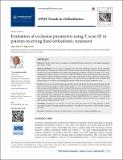DSpace Repository
Production and Decay of Up-Type and Down-Type New Heavy Quarks through Anomalous Interactions at the LHC
- DSpace Home
- →
- Web Of Science
- →
- Web Of Science
- →
- View Item
JavaScript is disabled for your browser. Some features of this site may not work without it.
| dc.contributor.author | Giray, Bilgin
|
|
| dc.date.accessioned | 2024-04-15T06:37:38Z | |
| dc.date.available | 2024-04-15T06:37:38Z | |
| dc.date.issued | 2015 | |
| dc.identifier.issn | 1687-7357 | |
| dc.identifier.issn | 1687-7365 | |
| dc.identifier.uri | http://hdl.handle.net/11547/11464 | |
| dc.description.abstract | Objectives: The aim of this study is to examine the relationship between occlusal factors and temporomandibular joint diseases (TMD).Material and Methods: In our study, 43 individuals who had fixed orthodontic treatment and 20 individuals who did not need treatment at Istanbul Aydin University Faculty of Dentistry Department of Orthodontics were included in the study. Evaluations were made at the beginning of treatment (T0) and at 6 months (T1). T-Scan (R) computerized Occlusion Analyzer was used to evaluate the number of contact points, occlusal force parameters during centric occlusion and lateral movements, and occlusion and disclusion times. Differences between groups were evaluated with Mann-Whitney or independent t-test, and within-group differences were evaluated with Wilcoxon sign test or paired t-test, depending on whether the data showed normal distribution or not.Results: There was no statistically significant distinction between the gender-based parameters and right and left joint of Joint Vibration Analysis record in all three groups (P > 0.05). At the beginning of orthodontic treatment, there was no statistical difference in the variables within the group and between the groups. As a result of the comparison between the beginning of treatment (T0) and the 6th month (T1), no significant difference was found between the parameters of the anterior/posterior occlusal force distribution of the right-left quadrant and the force distribution of the working and non-working sides in lateral movements, and the occlusion and disclusion time parameters. Maximum intercuspal position left/right (MxlntlTSCANT1) was found to be statistically significant at 6 months in individuals who received fixed orthodontic treatment with extraction compared to the none xtraction treatment group (P < 0.05).Conclusion: According to our research, T-scan is one of the best devices for the early detection of TMD, especially for people undergoing orthodontic treatment. T-scan offers fast, non-invasive, and repeatable occlusion recording. | tr_TR |
| dc.language.iso | en | tr_TR |
| dc.subject | HADRON COLLIDERS | tr_TR |
| dc.subject | PAIR PRODUCTION | tr_TR |
| dc.title | Production and Decay of Up-Type and Down-Type New Heavy Quarks through Anomalous Interactions at the LHC | tr_TR |
| dc.type | Article | tr_TR |
Files in this item
This item appears in the following Collection(s)
-
Web Of Science [1012]
